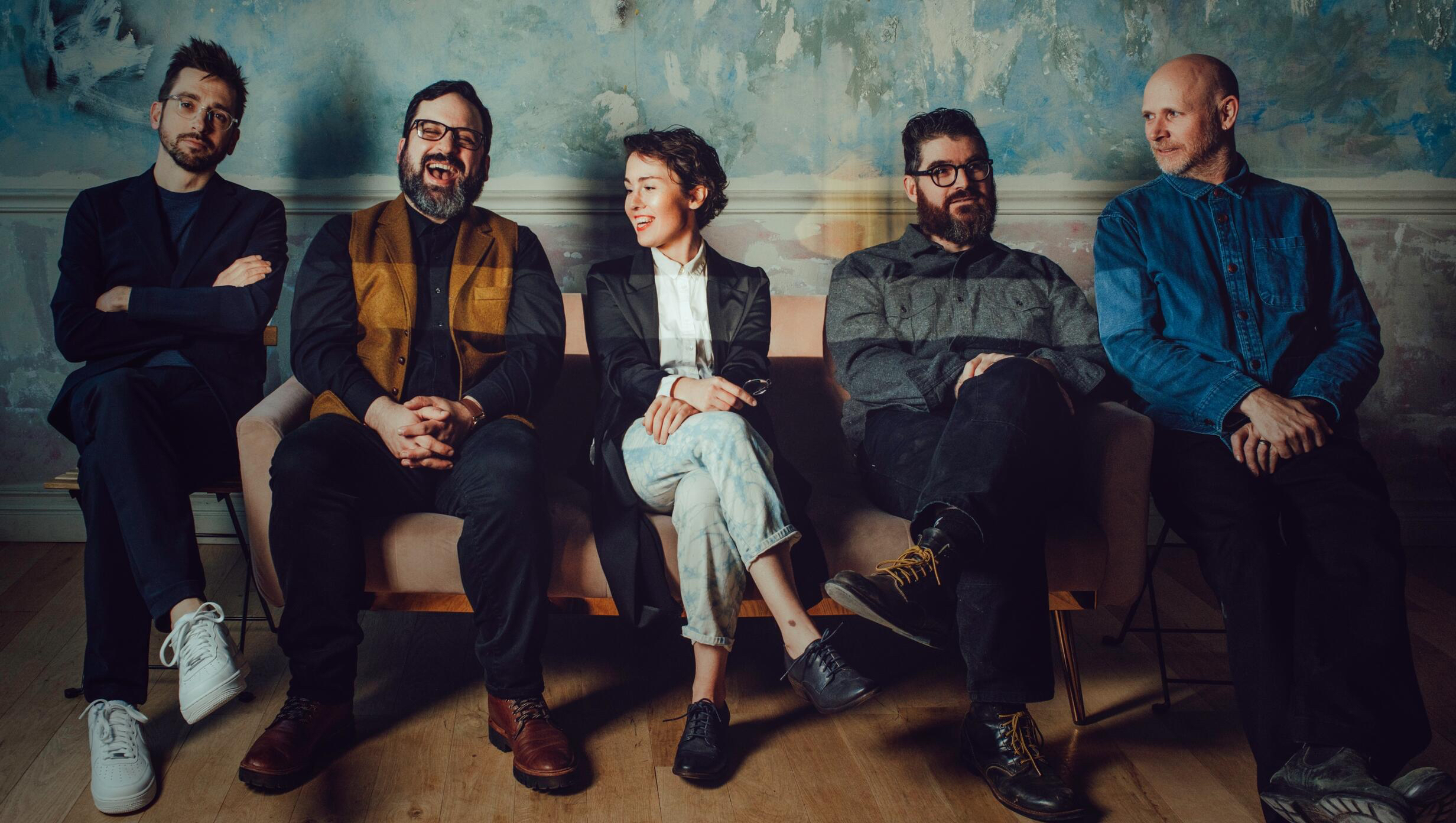
Pictured Above: Sō Percussion with Caroline Shaw (centered) to left: Eric Cha-Beach, Adam Sliwinski, Caroline Shaw; Right of Caroline: Josh, Quillen, Jason Treuting. Photo Credit: Anja Schütz.
An Interview with the GRAMMY Award-Winning Titans: Sō Percussion
By: Lori Goldstein
Princeton University’s Edward T. Cone Performers-in-Residence, Sō Percussion has just won a 2025 Grammy Award for their dynamic album “Rectangles and Circumstance,” release via Nonesuch Records. Music features writer Lori Goldstein speaks with half of the ensemble, Jason Treuting and Adam Sliwinski, about the quartet’s upcoming performance of “Re(new)al,” a percussion quartet concerto composed by Princeton University alumnus Viet Cuong. She also talks to Marc Uys, Executive Director of the Princeton Symphony Orchestra, who broached the idea of Sō Percussion performing “Re(new)al” with the Orchestra for the March 8th and 9th concerts.
According to Jenise Treuting, Jason’s sister, Sō comes from the second character in the compound Japanese word ensou, which means “to perform music.” By itself, Sō has multiple meanings: “to play an instrument,” “to be successful,” “to determine a direction and move forward,” and “to present to the gods or ruler.” The latter meaning is derived from the character’s etymology, which includes the element “to offer with both hands.” For a quarter century, Sō Percussion has been successful in advancing the art of percussion with “an exhilarating blend of precision and anarchy, rigor and bedlam.” (The New Yorker).
Timing is everything in the world of percussion, or you might say serendipitous. I just happened to schedule an interview with two of the four members of Sō Percussion, Adam Sliwinski and Jason Treuting–six days before the quartet won its Grammy Award with Princeton University alumna Caroline Shaw for Best ChamberMusic/Ensemble Performance, for their album Rectangles and Circumstance. Eric Cha-Beach accepted the award on behalf of the ensemble, which is complete with Josh Quillen. And just two days before their Grammy win, I attended Sō Percussion’s free concert with Pulitzer Prize-winning Caroline Shaw–composer, vocalist and violinist—and her duo Ringdown at Richardson Auditorium. The concert—a tour de force of sound, light, movement, and art—featured music from the Grammy-winning album and their first collaborative album, Let the Soil Play Its Simple Part. The vociferous reaction from the audience proved that Sō Percussion has a loyal hometown base in addition to world-wide renown for the past 25 years.
As Princeton University’s Edward T. Cone Performers-in-Residence since 2014, Sō Percussion has built its reputation on performing works commissioned for them. Their first commissioned percussion quartet concerto was man made, composed by Pulitzer Prize and Grammy Award-winner David Lang. It was commissioned by the BBC and the Los Angeles Philharmonic. They premiered it at London’s Barbican Centre in 2013 and at Disney Hall in 2014 with Gustavo Dudamel conducting.
“It’s a dream residency for a group like ours,” says Adam. “One of the main reasons that we were hired at Princeton is because they have such a flourishing composition program in the music department, and when it came time to consider bringing us here, they thought, what if all they do is pretty much create new work, either composing it themselves or working with composers. What we’ve been able to do over the last 11 years now is to [generate] as much of a create laboratory kind of feel for getting new work happening at Princeton, both with the faculty and the students, as we possibly can.”
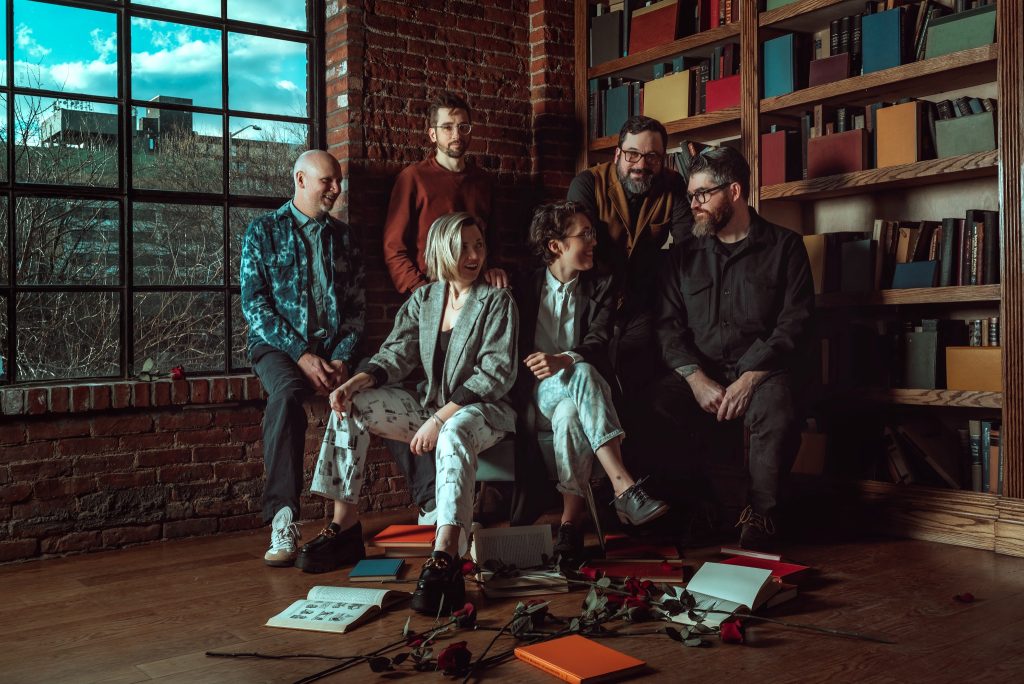
Pictured Above: Danni Lee and Caroline Shaw (the duo Ringdown) flanked by Jason Treuting, Eric Cha-Beach, Adam Sliwinski, Josh Quillen. Photo Credit: Anja Schütz.
“Our duties consist of saying, ‘Hey, what do you want to write? Do you want to write flower pot music or…typewriter music [both are examples of ‘found object’ instrumentation]. Our duties are basically to get in rooms with people and dream of crazy kinds of music that we can make together,” in addition to teaching a course on rhythm, coaching chamber music ensembles, working within the music department and sometimes in other departments “to contribute to the creative life of…the University,” Adam explains.
Sō Percussion is excited about their March 8 and 9 performances of Re(new)al, a percussion quartet concerto composed by Viet Cuong, a former student of theirs. “We almost [always] play [music] written for us,” says Jason. “But in this case…[Sandbox Percussion commissioned the piece from the composer that first wrote for us.” Indeed, while completing his doctorate, Viet wrote Water, Wine, Brandy, Brine for Sō Percussion, who premiered the piece in 2015. Adam points out that “Sandbox Percussion are younger colleagues of ours. One of them is actually a student of ours who came to our summer institute for a long time.”
And before Sō Percussion was in residence at Princeton, Jason taught an undergraduate class in composition for performers and composers at the University. That’s when he first met Viet. “It was really abnormal for a grad student to take an undergraduate course…He and another grad student were wonderful leaders within the class, and so open and interesting,” recalls Jason. “That really struck me that someone who didn’t really know me very well, wanted to just jump in with the undergrads and make music. There’s something really special about Viet.”
Sō Percussion performed a version of Re(new)al last fall with the Ithaca Wind Ensemble. “It warmed us a little bit for Princeton…This is our first time doing it with a symphony orchestra,” says Jason. He recalls that when Marc Uys, Executive Director of the Princeton Symphony Orchestra, approached them with the idea of performing Re(new)al, “it felt like the right kind of celebration” for a Princeton University alumnus. Reciprocally, Marc had “really wanted to do something with Sō Percussion for the longest time because they are extraordinary.”
Eric Cha-Beach loves to learn new instruments like the musical saw and specializes in electronic music. Josh Quillen is a steel-pan expert artist. Adam Sliwinski is a recognized marimba soloist who plays other keyboard instruments including the piano. Jason Treuting has pioneered an innovative drum set practice within the new music sphere. Not only are they percussionists unsurpassed in their instrumental areas of expertise, they also compose, conduct, and teach.
Along with Music Director Rossen Milanov and Katie Curatolo, Director of Artistic Operations, Marc has been integrally involved in the programming of works by composers and performers with connections to the University. Last season began with Forward Into Light by Princeton-based composer Sarah Kirkland Snider. Lumina, a piece by current doctoral student Nina Shekhar, opened a subsequent concert. It also featured Gregory Spears’s Love Story, sung by countertenor Anthony Roth Costanzo. Anthony was completing his undergraduate degree while Gregory was a graduate student in the composition department.
“There’s such a wealth of people who have Princeton connections,” points out Marc. “And when you’re choosing what to do, it’s almost overwhelming when you look at what all the options might be, and so that seems like an obvious way to narrow it down…to look at people who have some kind of connection [to the University], because that’s one of the roles we can play, is to highlight exactly those riches which come from this place.”
Marc became aware of Viet’s Re(new)al when he heard it performed by the Albany Symphony and Sandbox Percussion. The Symphony commissioned the work for its Dogs of Desire chamber ensemble in 2017, then for full orchestra in 2018–in partnership with GE Renewable Energy for the Symphony’s annual American Music Festival. “It’s a tremendous orchestra,” says Marc. “They play a lot of new music and commission a lot of works, so I always pay attention to what they’re doing. It’s a wonderful place for me to discover new [music].”
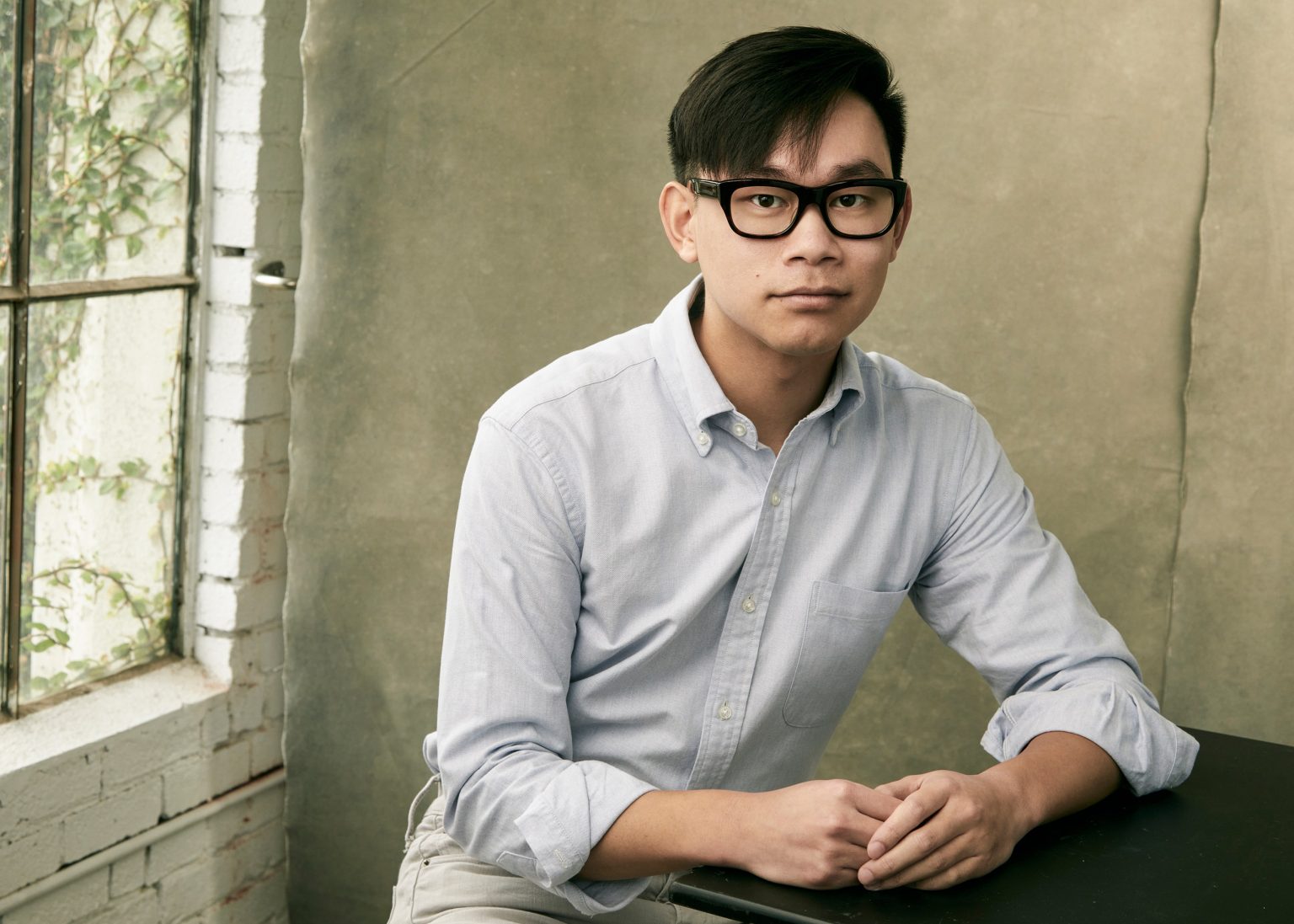
Pictured Above: Composer of Re(new)al, Viet Cuong. Photo Credit: Aaron Jay Young.
In his score notes for Re(new)al, Viet states that he has “tremendous respect for renewable energy initiatives and the commitment to creating a new, better reality for us all. Re(new)al is a percussion quartet concerto that is similarly devoted to finding unexpected ways to breathe new life into traditional ideas, and the solo quartet therefore performs on several ‘found’ instruments, including crystal glasses and compressed air cans.” During the time Viet was composing Re(new)al, he was invited to tour a GE Renewable Energy plant, hence the prescribed programmatic formula for the piece provided direction rather than restriction.
“While the piece also features more traditional instruments, such as snare drum and vibraphone, I looked for ways to either alter their sounds or find new ways to play them. For instance, a single snare drum is played by all four members of the quartet, and certain notes of the vibraphone are prepared with aluminum foil to recreate sounds found in electronic music. The entire piece was conceived in this way, and even the accompaniment was written with these ideas in mind.”
Viet, who used to play marimba as well as clarinet, has arranged the work in four different versions: for chamber orchestra, full symphony orchestra, wind ensemble, and chamber winds (to accommodate pandemic restrictions). The full symphony orchestral arrangement will be performed by Sō Percussion and the Princeton Symphony Orchestra.
“What this percussion quartet concerto tends to turn into is a concerto grosso,” says Adam. (In the Baroque era, a concerto gross featured a small group of instrumentalists accompanied by an orchestra.) “Also something like a Berlioz symphony, where it’s just the magnification of forces, like [Berlioz’s] Requiem, where he has tympani all over the place. Magnification of percussion forces just creates this wonderful monster of sound potentially. It can be a really fun thing to add us to a percussion section and to have that Berlioz-like scale.”
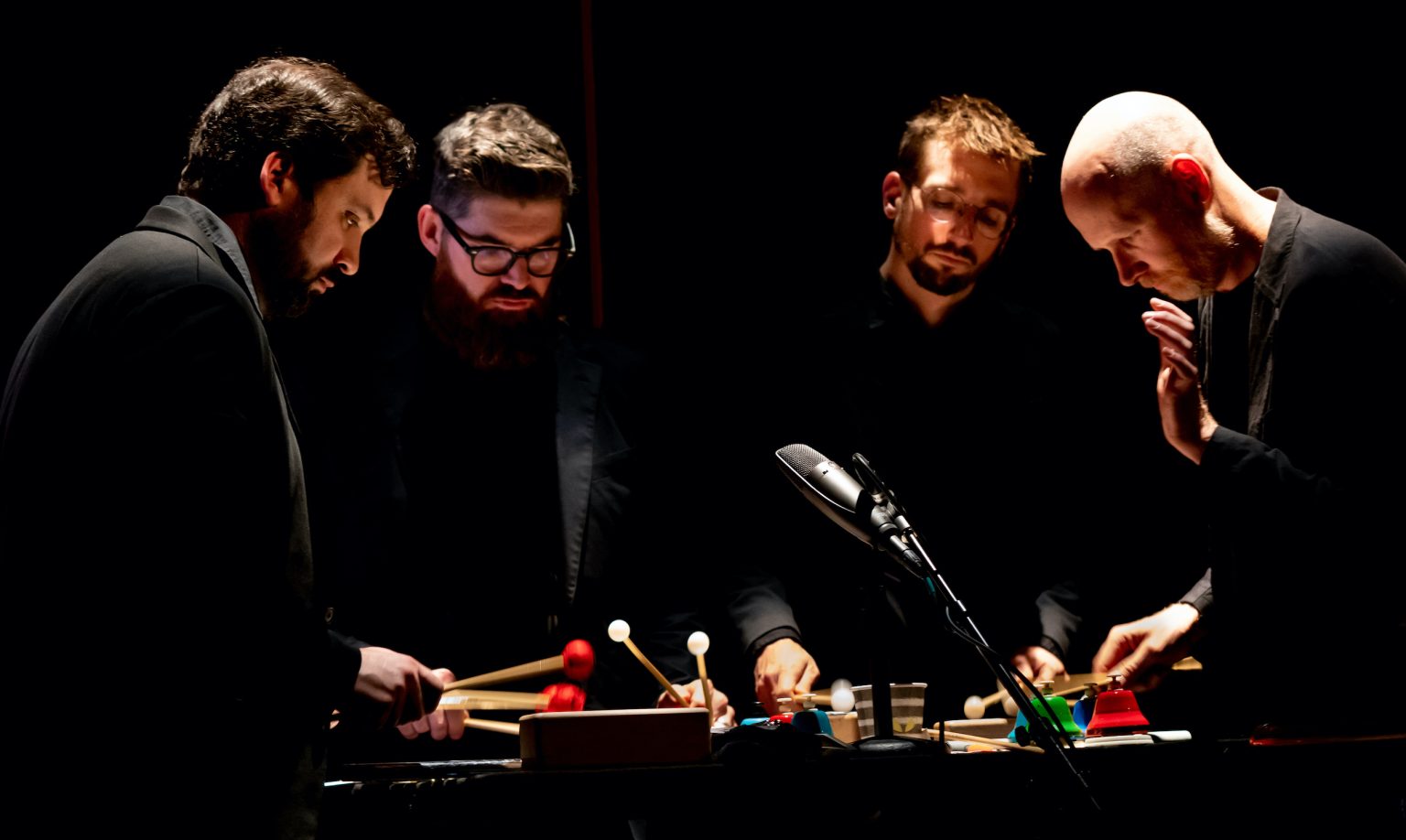
Pictured Above: Sō Percussion. Photo Credit: Victoria Pickering.
Jason concurs that “the [orchestra’s] percussion section is more involved oftentimes than a percussion section could be…I know in the first movement…we’re really listening to the piano and the mallet percussion for their timing to really connect with them…it’s like a mega-percussion celebration.”
In a post-performance video of the wind ensemble arrangement, Viet explains that “the four soloists are treated as one single soloist. All of the music is conceived as if I were writing a percussion solo, and I split up the music with a fancy term called a hocket [derived from the medieval technique of fragmenting the melodic line among different voices], so that the four of them are equally important, and there is never any time where one of the soloists busts out with their own solo. You see them move from one station to another as if they are one entity unto themselves, and the piece therefore, or the message of it is working together.”
One might view Water, Wine, Brandy, Brine as a precursor to Re(new)al. The earlier work’s sole instruments are found objects—crystal glasses half-filled with water. Each percussionist holds a glass in each hand. When they clink each other’s glasses, they sound dyads [two different pitches] simultaneously, in varying rhythmic patterns. Viet employs the same instrumentation—wine glasses and champagne flutes–in “Hydro,” the first of Re(new)al’s three continuous movements. “My favorite example of synergy in the piece is in the very opening, where the four soloists toast crystal glasses,” writes Viet in his score notes. “We always toast glasses in the presence of others, and oftentimes to celebrate new beginnings. This is my simple way of celebrating everyone who is working together to create a cleaner, more efficient world.”
He further states that “cooperation and synergy are also core themes of the piece, as I believe we all have to work together to move forward. “Wind,” the second movement, “turns each member of the quartet into a blade of a dizzying wind turbine, playing seemingly-impossible 90’s-inspired drum and bass patterns.” As they rotate around a snare drum, they’re also striking kick drums and hi-hats.
While each member of Sō Percussion specializes in different instruments, what “allows us to play a composite drum set together in the second movement, is that all of us covered enough drum set playing growing up that we can handle that,” Adam points out. “Part of the classical training for a percussionist is being able to cover the whole back of the orchestra in the percussion section. So that’s what allows us to play pieces where we do similar things together.”
Viet provides diagrams of where the soloists should be positioned for each movement, and choreography notes for how they should move within a movement, and from one station to the next at the end of a movement. “I would say we’re following [Viet’s notes] to the letter,” says Adam. “There’s one part that’s a little challenging but really cool, where we actually circle around a snare drum, and that’s a very prescribed [movement]. In fact, you have to actually, a little bit like a marching band, make sure your steps are measured exactly around, so that you don’t bump into the other guy.” (That’s when a drone camera could show they’ve become the wind turbine in the second movement.)
Viet describes “Solar,” the third and final movement as “essentially a sunrise. It’s the longest melody I’ve ever written, and it’s a very meditative movement where chords slowly rise, and it ends with a big climax where everyone comes together.” The glockenspiel is struck by all four percussionists, the vibraphones resemble solar panels, and the crotales [bronze or brass discs] are dipped in water or held near the snares of the snare drum for varying sound effects. To Jason, “the shimmery quality of the metallic instruments are a first clear connection to a solar quality. The movement builds to a bright and uplifting sound…we work together towards a common goal as we hocket on these instruments, and that aspect resonates with this environmental theme and hope for change and progress.”
Re(new)al is “in some ways more similar to the foundation of the group,” says Jason. “Early on, I think it’s fair to say that the kind of stamp that we put on our performances was a highly virtuosic, rhythmic, very fun kind of hocketing music. Viet really takes that idea and amplifies it…so it really highlights our kind of foundational work and our foundational skills.”
With the ecological promise that is one of Re(new)al’s themes, Beethoven’s 6th Symphony, the Pastorale—through which the great composer expressed solace in the countryside–is a natural programming partner in the March 8 concert. Carlos Simon’s Four Black American Dances features even more percussion, courtesy of the Orchestra’s own percussionists. It was commissioned by the Boston Symphony and premiered in 2023.
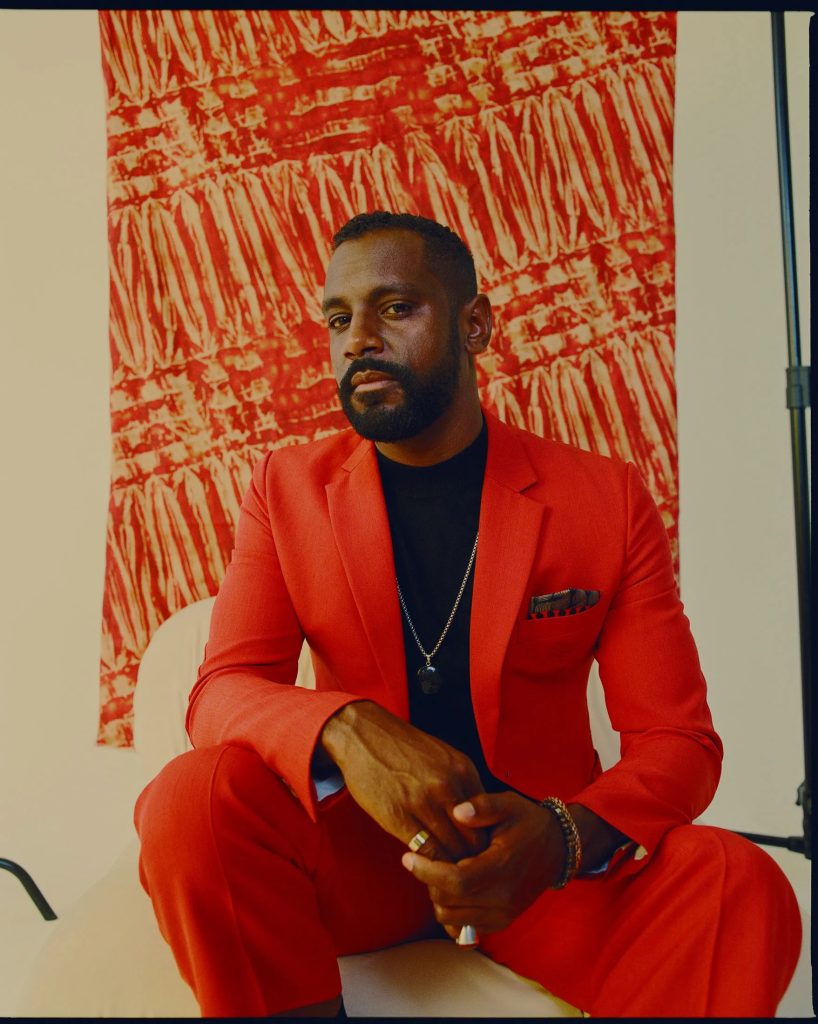
Pictured Above: Composer of Four Black American Dances, Carlos Simon. Photo Credit: Kendall Bessent.
Simon is the Composer-in-Residence for the John F. Kennedy Center for the Performing Arts and the inaugural Boston Symphony Orchestra Chair. He was nominated for a 2023 Grammy Award for his Requiem for the Enslaved. His Four Black American Dances is an orchestral study of the music that is associated with the Ring Shout, the Waltz, Tap Dance, and the Holy Dance—a representation of the thousands of dances created over the span of American history that have originated from the social climate of American slavery, Reconstruction, and Jim Crow.
“It was right at the time that we were finalizing our programming for this current season,” says Marc Uys. “We heard bits of Four Black American Dances, and immediately wanted to include it because it sounded extraordinary. I’ve since been able to see a full performance by the New York Philharmonic a couple months ago, so I’m excited to bring that to Princeton…It really rounds out, I think in many ways, the program that I’ve been looking forward to the most this whole season.”
Tickets to the March 8 and 9 concerts at Richardson Auditorium on the Princeton University campus are available @ princetonsymphony.org.
On March 4 at 7 PM in the Princeton Public Library, Sō Percussion will give a talk on “Found Sounds.” They will discuss the unique soundscapes which can be created using everyday items, and which they regularly incorporate in their music. The free talk takes place in the library’s Community Room.
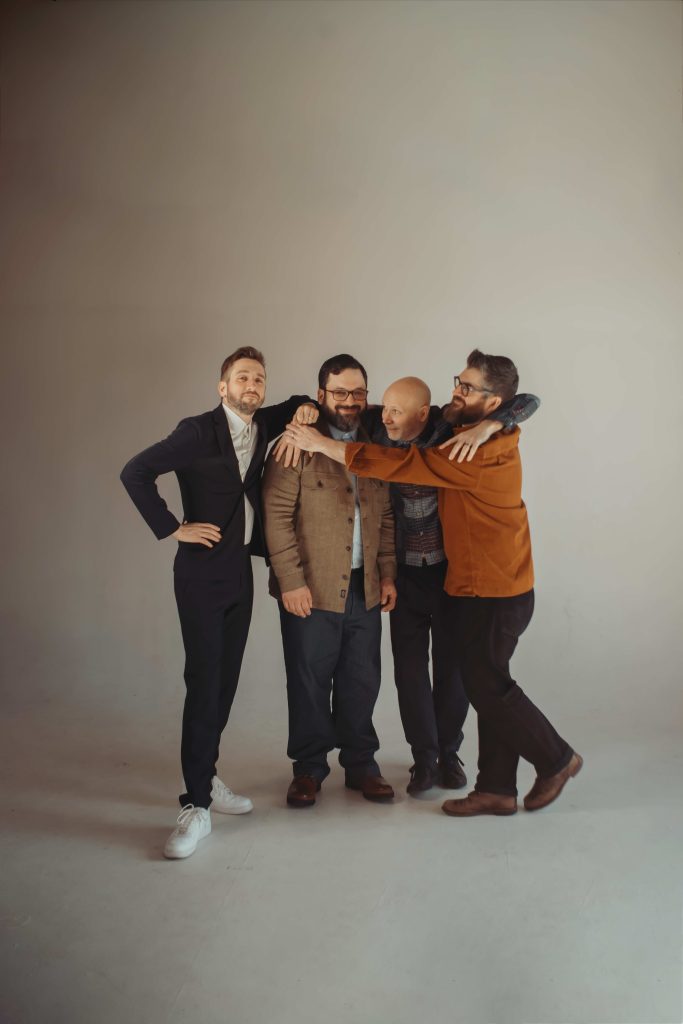
Pictured Above: Sō Percussion: L-R: Eric Cha-Beach, Adam Sliwinski, Jason Treuting, Josh Quillen. Photo Credit: Anja Schütz.

 Independent Arts News Reporting
Independent Arts News Reporting 
